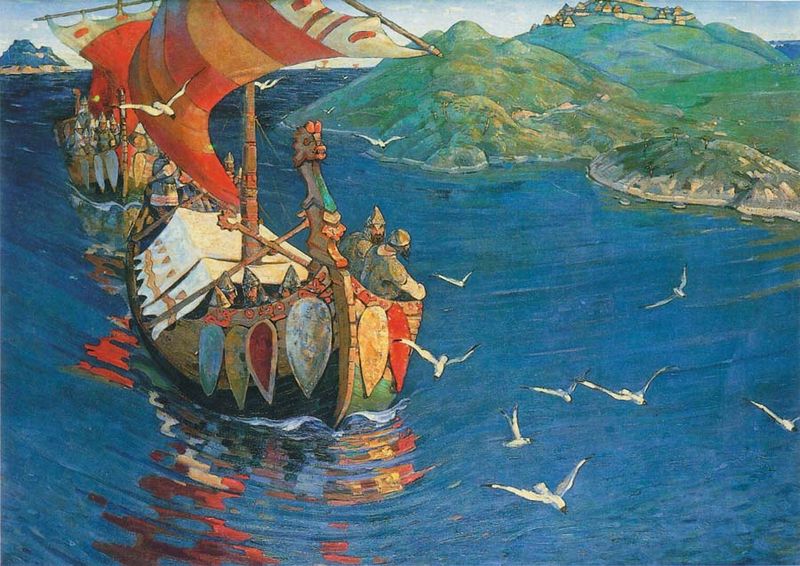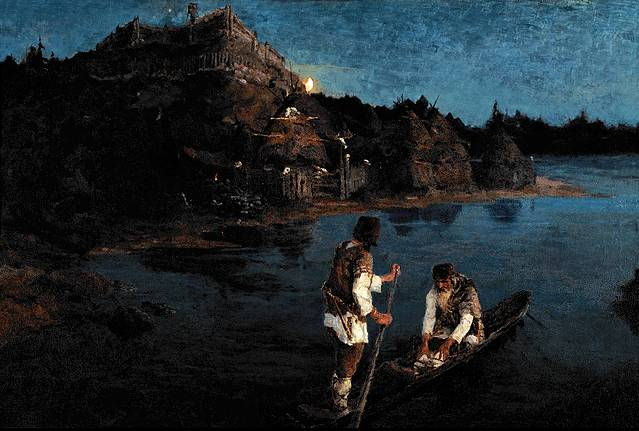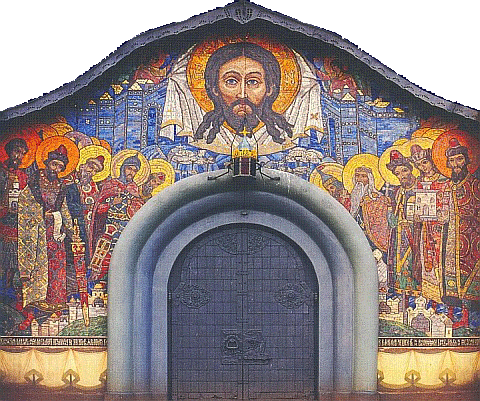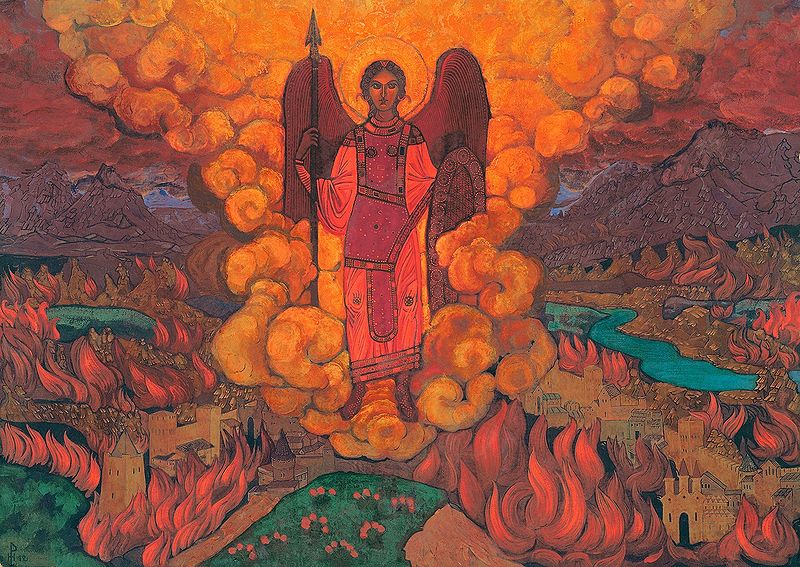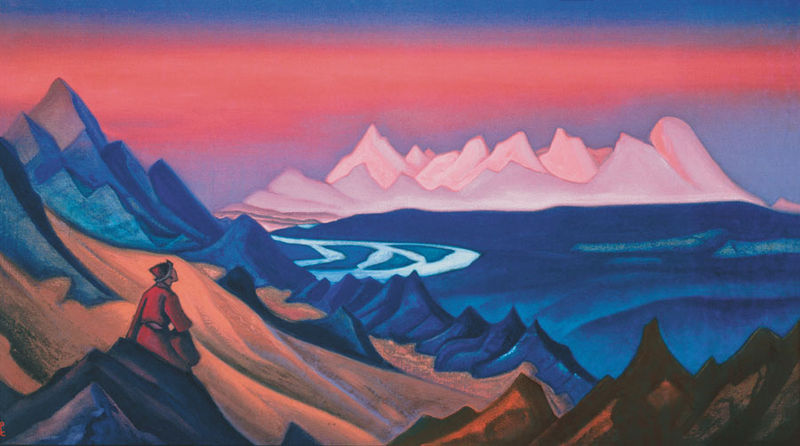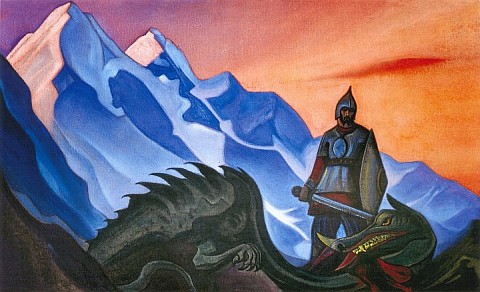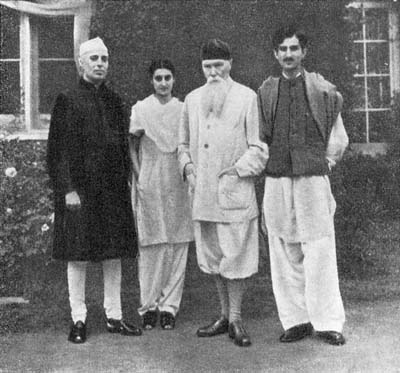<Back to Index>
- Physicist Karl Schwarzschild, 1873
- Painter and Philosopher Nikolai Konstantinovich Rerikh, 1874
- Lieutenant Colonel of the French Army Alfred Dreyfus, 1859
PAGE SPONSOR
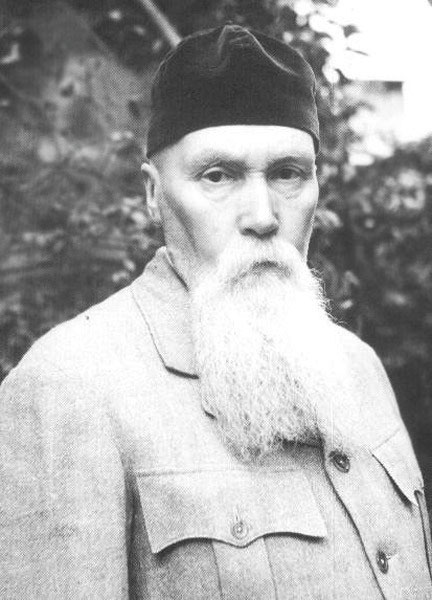
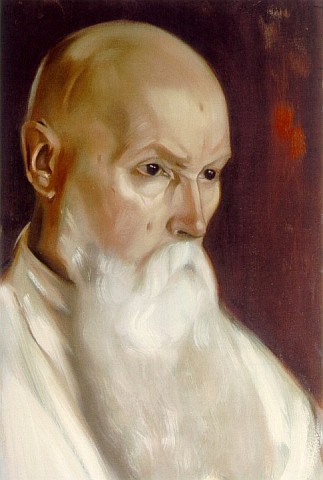
Nicholas Roerich, also known as Nikolai Konstantinovich Rerikh (Russian: Никола́й Константи́нович Рéрих; October 9, 1874 – December 13, 1947), was a Russian painter, philosopher, scientist, writer, traveler, and public figure. A prolific artist, he created thousands of paintings (many of them are exhibited in well known museums of the world) and about 30 literary works. Roerich was an author and initiator of an international pact for the protection of artistic and academic institutions and historical sites (Roerich’s Pact) and a founder of an international movement for the defence of culture. Roerich earned several nominations for the Nobel Prize.
Roerich in translation from the ancient Scandinavian means “rich of fame” (Rö Rich). Members of Roerich’s family occupied prominent military and administrative posts in Russia since the reign of Peter I. Nicholas Roerich’s father Konstantin Fedorovich was a well known notary who was born in Courland. N. Roerich’s mother Maria Vasil’evna Kalashnikova was descended from a long line of merchants and traders. Among friends of the Roerich’s family were such famous personalities as D Mendeleyev, N. Kostomarov, M. Mikeshin, L. Ivanovsky etc. From childhood Nicholas Roerich was attracted to painting, archaeology, history and the abundant cultural heritage of the East.
Nicholas Konstantinovich Roerich was born in St. Petersburg, Russia, on October 9, 1874, the first born son of lawyer and notary, Konstantin Roerich and his wife Maria. When he was nine, a noted archeologist came to conduct explorations in the region and took young Roerich on his excavations of the local tumuli. The adventure of unveiling the mysteries of forgotten eras with his own hands sparked an interest in archeology that would last his lifetime. His father did not want him to pursue painting as a career, but rather to study law. He made a compromise, and after finishing his studies in 1893, Nicholas Roerich simultaneously entered the Saint Petersburg University (he graduated in 1898) and the Emperor’s Academy of Arts. From 1895, he studied in the studio of the famous Russian landscape painter Arkhip Kuindzhi. At that time, he closely communicated with various well known artists, writers and musicians – V. Stassov, I. Repin, N. Rimsky - Korsakov, D. Grigorovich, S. Diaghilev. During his student years in Saint Petersburg Roerich had already become a member of the Russian archeological society. He had conducted numerous excavations in St. Petersburg, Pskov, Novgorod, Tver, Yaroslavl and Smolensk provinces. From 1904, together with Prince Putyatin, he recovered several Neolithic sites at Valdai (near Pyros lake). Roerich’s Neolithic findings excited real sensation in Russia and West Europe.
In
1897, Roerich graduated Petersburg Academy of Arts. His graduation
painting “The messenger” was purchased by famous collector of Russian
art P.M. Tretyakov. V.V. Stassov, well known critic of that
time, highly appreciated this painting: “You certainly must visit
Tolstoy … let the great writer of Russian land himself promote you in
painters”. Meeting with Leo Tolstoy determined the way of young Roerich. Leo Tolstoy said
to him: “Have you an occasion to pass the fast river on boat? It is
necessary always to drive upstream of that place where you need or
river carries you away. Then in the field of moral requirements one
must drive always higher so that life all the same carries away. Let
your messenger keep the rudder very high, then sail!”. Words of St. John of Kronstadt who
often visited the house of Roerich’s family also became spiritual
wishes for N. Roerich: “Don’t be ailing! You will work much for
the Motherland”. Roerich
worked much in historical painting. In his early period he created
the following canvases: “Elders coming together” (1898), “Lamentations
of Yaroslav’s daughter” (1893), “Beginning of the Russia. The Slavs”
(1896), “Idols” (1901), “Building of boats” etc. N. Roerich’s
original talent and pioneer search in the art were manifested in these
paintings. “The distinctive Roerich’s style became already clear in the
earliest paintings. It consists in Roerich’s broad approach to
composition, clarity of lines, laconism, color purity, musicality,
great simplicity of expression and truthfulness. His
paintings were built on a deep knowledge of the historical material; they
reproduce the feeling of spirit of the times and were rich in
philosophical content. At
the age of 24, Nicholas Roerich became an assistant to the Director of the
Emperor’s Art Encouragement Society Museum and, at the same time,
assistant editor of the art magazine “Isskustvo i khudozhestvennaya
promishlennost” (“The Art and Art Industry”). Three years later he
occupied a position of secretary of the Emperor’s Art Encouragement Society. In
1899, he met Helena Ivanovna Shaposhnikova. On October, 1901 their
wedding took place. Helena Ivanovna became an inspiration for Nicholas
Roerich. They would complement each other creatively and spiritually.
In 1902, their son George was born, a future scientist - orientalist,
and
in 1904 – Svetoslav, a future painter and public figure. In
1903 – 1904, N. Roerich together with his wife made a trip around old
cities of Russia. They visited more than 40 cities famous for their
ancient monuments. The aim of this “trip over the ancient times” was
studying the roots of the Russian culture. The trip resulted not only
to a large series of paintings (near 90 sketches), but also
to some of N. Roerich’s articles, in which he was one of the first to raise the
issue of a great artistic value of the old Russian icon painting and
architecture. N.
Roerich as painter worked in the field of easel, monumental painting
(frescoes, mosaics) and also theatrical - decorative painting. In 1906, he
created 12 sketches for the church in Golubev’s estate Parkhomovka near
Kiev, sketches for Pochaev lavra mosaic (1910), 4 sketches for wall
paintings of a chapel in Pskov (1913), 12 pictures for Livshiz’s villa
in Nice (1914). In 1914, he designed a Holy Spirit church in Talashkino. Nicholas Roerich’s multi - faceted talent brightly showed itself in his works for theatre productions: “Snow Maiden”, “Per Gynt”, “Princess Malen”, “Valkyrie” and others. During Sergey Diaghilev’s
famous “Russian Seasons”, N. Roerich did the designs for “Polovets Dances” from Borodin’s “Prince Igor”, “Pskovityanka” by
Rimsky - Korsakov, and the ballet “Sacred Spring”, better known as Rite of Spring, to Stravinsky’s music. The Epoch
of Silver Age where N. Roerich began his creative development was
the epoch of spiritual rise and that undoubtedly affected the formation
of the artist. A galaxy of outstanding thinkers such as V.S.
Solovyev, E.N. Trubetskoi, V.V. Rozanov, P.A. Florensky,
S.N. Bulgakov, N.A. Berdyayev etc. brought in Russian
culture a deep philosophical thought. The Eastern culture was of particular interest for Russian intellectuals. In
search of universal values N. Roerich besides Russian philosophy
also studied Eastern philosophy, e.g., the works of outstanding Indian thinkers
Ramakrishna and Vivekananda, and the works of R. Tagore. This acquaintance
with the oriental philosophic thought is reflected in N. Roerich’s
creative work. While the core subjects of the artist’s earlier
paintings were ancient pagan Russia, colorful images of the folk epos
(“They Build a City”, “Ominous”, “Guests from overseas”, etc.),
starting already from the middle of the 1905, many of his canvases and
literary pieces were devoted to India (“Lakshmi”, “Indian path”,
“Krishna”, Indian dreams” etc.). Roerich as a painter and a scientist was
interested in the ancient cultures of Russia and India and their common
origin. A correlation between temporal categories of past, present and
future was of great importance for his historical perspective. Roerich
measured the past and the present by the future: “… when we call for
the study of the past, we do it only for the sake of future”. “Let’s construct the steps of the future from ancient wonderful stones”. From
1906 to 1918, N. Roerich was Director of the School of Emperor’s Art
Encouragement Society and at the same time he was busy with teaching.
From this time the artist became a permanent participant of foreign
exhibitions. He exhibited in Paris, Venice, Berlin, Roma, Brussels,
Vienna. His paintings were purchased by the Roman National Museum, the
Louvre and
other European museums. From
1906, Roerich’s creativity entered a new more mature period. N. Roerich
changed towards an approach to historical themes. History, mythology,
folklore became sources, from which the artist got the material for his
art. Realism
and symbolism were combined in his art. In this period, N. Roerich
intensified his explorations in the field of color. He almost abandoned oil
and passed to temperas. He experimented with painting
composition, and used a method of superposition of colors.
From
1907 to 1918, nine monographs and several artistic magazines
devoted to N. Roerich’s art were published in Russia and Europe. Leonid Andreyev figuratively named a world, created by the artist, as “Roerich’s Empire”. In
1909, N. Roerich was elected as Academician of the Russian Academy of
Arts and a member of the Rheims Academy in France. In
1910, he became the head of the artistic association “World of Art”,
whose members included A. Benois, L. Bakst, I. Grabar, V. Serov, K.
Petrov - Vodkin,
B. Kustodiev, A. Ostroumova - Lebedeva, Z. Serebryakova. The “Greatest
intuitionist of the century”, according to an expression of A.M. Gorky, N.
Roerich expressed his forebodings on the eve of the First World War in
symbolic images: “Fairest City is the enemies’ vexation”, “The Last
Angel”, “Glow”, “Human works”. These paintings demonstrate both the struggle between two sides – Light and Darkness, which runs
through the whole Roerich’s art, and the human's responsibility for his own
destiny and that of the world. N. Roerich not only created paintings with an anti-war orientation, but also wrote articles
devoted to the protection of peace and culture. In
1915, N. Roerich made a report to Emperor Nikolai II and Grand Prince
Nikolai Nikolayevich (Younger) containing a call to take serious
measures for the protection of cultural treasures. In 1916,
because of a serious lung illness, Roerich together with his family moved to Sortavala, Finland, on the shore of Lake Ladoga. On
March 4, 1917, a month since the February revolution, M. Gorky gathered
in his apartment a group of painters, writers and actors,
including N. Roerich, A. Benois, Bilibin, Dobuzhinskii, Petrov -
Vodkin,
Schuko, Shalyapin. On the meeting they elected a Committee for arts
affairs. M. Gorky was elected as a head of this Committee and A. Benois
and N. Roerich were elected as assistants. The Committee
examined the questions of art development in Russia and protection of
old relics and monuments. After
the revolution events in 1917 Finland closed its border and
Roerich with his family were isolated. In
1919, having received an invitation from Sweden, N. Roerich exhibited
around the Scandinavian countries, and in autumn of the same year, on
Diaghilev’s invitation, he designed for Russian operas by M. Mussorgsky
and A. Borodin in London. In
1920, N. Roerich got an invitation from the Director of the Chicago
Institute of Arts to organize a big exhibition tour in 30 cities of
the USA. Among 115 his paintings the following were exhibited: “Angel’s
treasure” (1905), “The last angel” (1912), “Viking’s daughter” (1917),
“Call of the sun” (1918), “Ecstasy” (1917), the series “Heroism” and
“Dreams of the East” etc. The exhibitions were a great success. In
America, N. Roerich created the following series: “Sancta”, “New
Mexico”, Ocean’s suite”, “Dreams of wisdom” etc. In
America he founded cultural and enlightenement organizations, which
became great cultural centers and attracted many
prominent art figures. In November, 1921, the Master Institute of
United Arts was opened in New York. Its main purpose was to bring
peoples together through culture and art. Almost
at the same time, the artists association “Cor Ardens” (“Blazing Hearts”)
was established in Chicago, and in 1922, the International Cultural
Center “Corona Mundi” (“Crown of the World”) opened. On November,
1923, the Nicholas Roerich Museum in New York was found. It contained a
rich collection of the artist’s paintings. Sale
of the paintings, fees for theatric performances, publication of
numerous articles, activities of these American cultural organizations
gave N. Roerich the financial ability to accomplish a
scientific expedition in Central Asia. On December 2, 1923, N. Roerich
and his family arrived in India, which attracted the attention of N.
Roerich not only as a painter, but as a scientist interested in a
number of issues related to ancient peoples’ world migrations, and
search for a common source of Slavic and Indian cultures. From there,
they visited areas of Central Asia. Later N. Roerich wrote: “Besides
the artistic tasks of our
expedition, we have intended to clarify the situation with the relics
of the
past of Central Asia, to observe the modern state of religion, customs,
and
to register the traces of great migration of peoples. This last task
was always of interest to me”. The expedition went through Sikkim,
Kashmir, Ladakh, China (Sintzian), Russia
(including Moscow), Siberia, Altai, Mongolia, Tibet, and unstudied
areas of
Trans Himalayas. It was continued from 1924 to 1928. Having
realized Przewalski's and Kozlov’s dream, Nicholas Roerich’s expedition
became a triumph of Russian studies in Central Asia. In terms of the
uniqueness of its path and of the collected materials, it can justly
claim a
special place among the major expeditions of the 20th century. Archeological
and ethnographical investigations in unexplored Asian areas were
conducted. For the first time, dozens of new mountain peaks and passes
were marked on maps, rarest manuscripts were found, richest linguistic
materials and folkloric works were collected, descriptions of local
customs were made. Also during the expedition the books “Heart of Asia”
and “Altai - Himalayas” were written, about five hundred paintings were
created, a famous painting series “Himalayas” was began,
the series “Maytreya”, “Sikkim’s Path”, “His country”, “The Teaches of
the East” etc. Extensive
scientific material, collected by Roerichs during the expedition,
required systematization and treatment. After the expedition ended in
July 1928, in the Western Himalayas, Kullu Valley, N. Roerich founded
the Institute of Himalayan Studies “Urusvati”, Sanskrit for “Light of the Morning Star”. In this place, Kullu valley,
N. Roerich lived the last period of his life. The director of the Institute
became George Roerich, elder son of N. Roerich, a world - known
orientalist. He directed ethnological and linguistic researches and
also reconnaissance of archeological monuments. In the institute there
were medical, zoological, botanical, biochemical and many other
laboratories. Large work was conducted in the field of linguistics and
Eastern philology. Rare written sources of centuries - old remote areas
were collected and translated in European languages; half-forgotten
dialects were studied. Visiting specialists and workers
collected botanical and zoological collections. Tens
of scientific institutions from Asia, Europe and America collaborated with
the Institute “Urusvati”. Scientific materials from Kullu came in
the University of Michigan, New York’s Botanical Garden, University of
Punjab, Paris Museum of natural history, Harvard University, the Botanical garden of USSR Academy of Sciences. Famous Soviet
botanist and geneticist academician N.I. Vavilov appealed to the institute
“Urusvati” for scientific information and received from there the seeds
for his unique botanical collection. Such famous scientists, as A.
Einstein, L. de Broil, R. Milliken, Sven Guedin etc. also
collaborated with the institute.
In
1934 – 1935, Nicholas Roerich conducted an expedition in Inner Mongolia,
Manchuria and China, organized by the US Department of Agriculture. The
expedition's purpose was to collect seeds of the plants preventing the
destruction of benign layers of soil. The expedition consisted of two parts. The first
itinerary included the Khingan mountain ridge and the Bargin plateau (1934),
the second one – the Gobi Desert, Ordos and Alashan (1935). These
itineraries passed through a territory of Inner Mongolia located in
northern and east - northern parts of modern China. As a result of the
expedition, nearly 300 species of xerophytes were found, herbs were
collected, archeological studies were conducted, and antique
manuscripts of great scientific importance were found. In
his philosophic and artistic essays, Roerich created an absolutely new
concept of culture based on the ideas of the Living Ethics. Culture, in
N. Roerich’s opinion, is closely related to the problems of cosmic
evolution of mankind and is “a greatest foundation” for this process. He wrote: “Culture is based on Beauty and Knowledge”. And he repeated a well known phrase of Dostoevsky: “Awareness of Beauty saves the world”.
The beauty becomes known to people through Culture only, and its
integral part is creation. Roerich included in the broad notion of Culture a synthesis of the best
achievements of human spirit in the sphere of religious experience,
science, art, education. He formulated the principal
difference between Culture and civilization. While Culture relates to
the spiritual world of man in his creative self-expression,
civilization is just external arrangement of human life in all its
material and civil aspects. Identification of civilization and Culture,
Nicholas Roerich argued, leads to confusion between these two notions,
to underestimation of the spiritual factor in the development of
humanity. “Wealth in
itself does not generate Culture. But broadened and subtler thinking
and the sense of Beauty produce that subtlety, that nobility of spirit
which are distinctive for a cultured person. It is this kind of person
that can build the future of light for its country”. Proceeding from this, the mankind must not only develop Culture, but is also obliged to protect it. In
1929, N. Roerich in collaboration with doctor of international law from
Paris University G.G. Chklaver prepared a draft of an agreement
dedicated to protection of cultural values (Roerich’s Pact). Coupled
with the Pact Roerich proposed a distinctive sign for identification of
protected objects – Banner of Peace - which was a white cloth
containing
a red ring and three red circles inscribed in it. The sign symbolized a
unity of the past, present and future into the ring of eternity. In
1929, N. Roerich was nominated for the Nobel prize for his
international
cultural activity and Pact initiative. In
1930, the text of a draft agreement with an accompanying appeal to
governments and peoples of all countries was published in the press and
distributed in government, scientific, artistic and educational
institutions around the world. As
a result, committees supporting the Pact were established in many
countries. The draft pact was approved by the Committee for museum affairs
at the League of Nations and also by the Pan-American Union. Roerich’s Pact has a large educational value. “A
pact for the protection of cultural treasures is not only needed as an
official body, but as an educational law that, from the very first
school days, will educate the young generation with noble ideas of
preservation of the whole mankind’s true values”, – wrote N. Roerich. The idea
of the Pact was welcomed by R. Rolland, B. Shaw, R. Tagore, A. Einstein, T. Mann, H. Wells. The
Pact was signed in the White House in Washington, on April 15, 1935
with the participation of US President F. Roosevelt. Originally, the
document was ratified by 21 countries of the American continent. Later
the Pact was validated by 15 more countries. Roerich’s
Pact became the first international act especially devoted to
protection of cultural values. It was a unique agreement in this field,
which was accepted by part of the international community before second
World War. A few years after the war, Roerich’s Pact played an important role in
forming international law standards and public activism in the field
of protection of cultural heritage. In 1949, the fourth session of the general UNESCO conference
voted for a decision to begin the work for adopting international law
regulations in the field of cultural heritage protection in case of
armed conflict. In
1954, Roerich’s Pact was the basis for the Hague “International
Convention for Protection of Cultural Values in the Event of Armed
Conflict”, and
the suggested special flag, the Banner of Peace, declaring all
treasures of culture and art inviolable objects, still flies today
above many cultural and educational institutions all over
the world. The
painting “Madonna Oriflamma” was especially devoted to the Pact. Being
in India, Nicholas Roerich from very first days of Second World War
used all opportunities to help Russia. Together with his younger son
Svyatoslav Roerich he organized exhibitions and sales of paintings,
transferring all gains to the Soviet Red Cross fund and Red Army. He
published articles in press; spoke on the radio in support of the soviet
people. During
those formidable years for Russia, the painter turned again to the
subject of native land in his creative work. In that period, he created
a whole series of paintings – “Prince Igor campaign”, “Alexander
Nevsky”, “Partisans”, “Victory”, “Heroes have awaken” and others, in
which he used the images of the Russian history, predicting the Russian
people’s victory against the fascism. When
the fascist forces occupied extensive Soviet territories,
N. Roerich
made a request to his workers to serve for mutual understanding between
Russia and USA. In 1942, the American - Russian cultural Association
(ARCA) was created in New York. Its active participants were Ernest Hemingway, Rockwell Kent, Charlie Chaplin, Emil Cooper,
S. Koussevitzky, P. Heddas, V. Tereshchenko. The association’s activity was
welcomed by world known scientists R. Milliken and A. Compton. The
Russian painter’s world recognition is confirmed by the fact that more
than a hundred institutes, academies, scientific corporations, cultural
institutions had chosen him as their honorary and full
member. In India, famous Indian philosophers, scientists, writers, public figures were personally acquainted with Nicholas
Roerich. In
India Roerich continued to work at the “Himalayas” series which includes
more than two thousands paintings. The mountain world was a source of
inexhaustible inspiration for the painter. Art critics noted a new
direction in Roerich’s creativity and called him “Master of mountains”.
In India Roerich created the following series: “Shambala”,
“Chingis - Khan”, “Kuluta”, “Kullu”, “Saint mountains”, “Tibet”, "Ashrams”
etc. Exhibitions were held in many Indian cities and attracted
many people. Roerich always remained a patriot and a Russian citizen only holding
one passport – Russian. He never gave up the thought of coming back to
his motherland. Right after the end of the war, the artist applied for
a visa to enter the Soviet Union. But on December 13, 1947, he died,
without knowing that he was denied the visa. In
Kullu valley, at the place of the funeral fire, a big rectangular stone
was installed on which the following inscription was carved: In
1990, Svetoslav Roerich, younger son of Nicholas and Helena Roerich,
implementing his parents will, has transferred to the Soviet Roerich’s
Foundation (now International Centre of the Roerichs (ICR)) the richest
heritage of his family. Due to L.V. Shaposhnikova, noted
scientist, writer, and academician of Russian Academy of Nature Sciences, and Yu.M. Vorontsov, Ambassador Extraordinary and Plenipotentiary of Russia, more than 400 paintings, archives, library and
Roerich’s family antiquities were imported back to Russia. This heritage
became a base for a Museum, named after Nicholas Roerich, opened in
Moscow. S.N. Roerich chose for the future museum an ancient mansion of
the Lopukhins. On February 12, 1993, the first museum exhibition was opened
in this building. In
October 15, 1969 a minor planet of Solar System was discovered by
astronomers of the Crimea astrophysical observatory Nikolai Stepanovich and
Lyudmila Ivanovna Chernikh. This planet was named in honor of Roerichs
family. It was numbered 4426.
On August 15, 1963 in the Independence day of India the alpinists from
Tomsk V.Sirkin, G. Shvartsman, A. Ivanov, V. Petrenko, L. Spiridonov,
G. Skryabin, V. Slyusarchuk, Yu. Salivon, D. Gusev, S. Lobanov had climbed on a nameless as yet mountain peak and named it after N. Roerich.
Let there be peace”.
